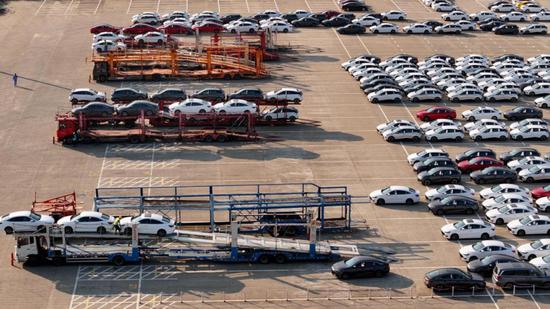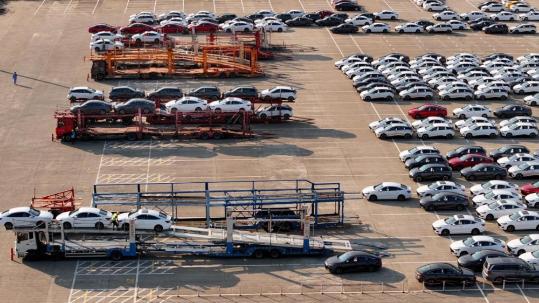Renewals, trade-ins unlock investment, consumption

Passenger cars wait to be shipped in Ningde, Fujian province, for sale to various markets on Oct 10. (WANG WANGWANG/FOR CHINA DAILY)
China's stimulus package, which includes incentives for large-scale equipment renewals and consumer goods trade-ins, has helped to boost investment growth, unlock consumption potential, and better facilitate economic recovery amid domestic downward pressure, officials and analysts said.
The technological upgrade and green transformation driven by the initiatives will pay dividends, not only in terms of immediate economic benefits but also in laying the foundation for a more sustainable development path, they added.
In March, the State Council, the country's Cabinet, launched a plan to promote large-scale equipment upgrades and old-for-new exchanges of consumer goods. This was followed by an additional measure in July, where the government allocated around 300 billion yuan ($42.4 billion) in long-term special government bonds to further support these initiatives.
All 31 provincial-level regions on the mainland have issued implementation plans to further support these initiatives, complementing the central government's policy framework, said Zhao Chenxin, deputy head of the National Development and Reform Commission, during a recent news conference.
In terms of equipment renewal, China has set targets to increase investment in a wide range of sectors, including manufacturing, agriculture, construction, transportation, education, culture, tourism, and medical care, by at least 25 percent by 2027, compared to 2023 levels, as outlined in the plan.
The commission has streamlined the approval process and identified over 4,600 eligible projects, with the 150 billion yuan in special bonds for equipment upgrades already allocated to these initiatives in two batches, Zhao added.
China's investment in the purchase of equipment and tools grew by 16.8 percent year-on-year in the first eight months of the year, outpacing the overall growth in fixed-asset investment by 13.4 percentage points, and contributing 64.2 percent to total investment growth, data from the commission showed.
This Jan-Aug figure represented a 3.5 percentage point increase compared to the first seven months, indicating that the government's intensified policy support for equipment upgrades had a more pronounced effect in August, Zhao said.
According to preliminary estimates, the equipment upgrade projects supported by government bond funding this year will involve a total investment of nearly 800 billion yuan, said Liu Dechun, director-general of the commission's department of resource conservation and environmental protection.
This can facilitate the replacement of more than 2 million units of various types of equipment, resulting in energy savings of equivalent to approximately 25 million metric tons of coal per year, Liu added.
As the world's largest manufacturing powerhouse, China accounts for around 30 percent of global manufacturing value added, and is home to the largest inventories of various types of machinery and equipment globally. With the ongoing advancement of industrialization and urbanization, the demand for advanced equipment continues to grow, presenting a vast and significant opportunity for equipment upgrades, analysts said.
The speed of technological change has created a situation where a significant portion of the equipment currently in use is no longer adequate to address the evolving needs of modern industrial production, said Wen Bin, chief economist at China Minsheng Bank.
The combination of aging infrastructure, outdated features, and a lack of digital and smart capabilities has become a critical issue that Chinese manufacturers must address to remain competitive and drive sustainable growth, Wen explained.
"Upgrading the equipment is not just about improving efficiency and productivity, but also about ensuring that industries can adapt to the increasingly digitalized and intelligent operating environments of the future," he said.
Faced with a cloudy external environment, particularly in terms of the global trade landscape, by channeling resources toward initiatives that can directly boost domestic demand, the government can create a more stable foundation for economic development, Wen added.
In a production workshop of Wison Group, a Zhoushan-based offshore engineering company in Zhejiang province, a new batch of fully automated production lines has been put into operation to undertake the manufacturing of modules for floating liquefied natural gas facilities.
"In the first half of this year, we invested 540 million yuan to purchase new machinery and equipment, which is more than five times the amount compared to the same period last year," said Xu Tianfeng, the company's chief financial officer. "After the equipment update, we have been able to accept a wider range of high-tech manufacturing tasks, which has greatly broadened our company's business horizons."
To address the financing needs of enterprises undertaking equipment upgrades, the People's Bank of China, the country's central bank, has, in coordination with relevant departments, established a 500 billion yuan re-lending facility for technological innovation and technical transformation, with an interest rate of 1.75 percent.
The re-lending facility, which channels low-cost funds to banks for on-lending to eligible enterprises, is a crucial tool to empower businesses to invest in advanced technologies and the equipment they need to enhance their competitiveness and drive sustainable growth, said Peng Lifeng, deputy head of the bank's financial market department.

